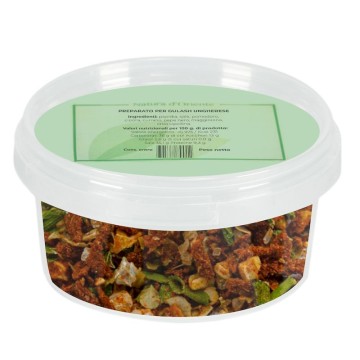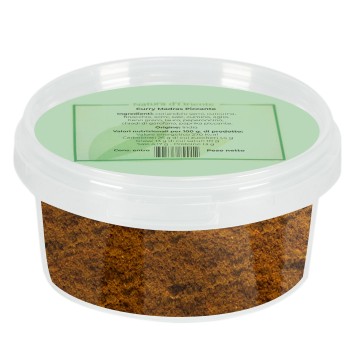This ground cinnamon comes from the dried bark of Cassia cinnamon, and can be used for both food and wellness purposes. It is mainly used in recipes due to the convenience of the powdered form, practical for adding to sweet and savory dishes. Its taste is intense, pungent with sweet notes, warm, perfect for flavoring with a strong tone in combination with its persistent aroma. Cassia cinnamon powder is ideal for flavoring meat-based dishes, both first and second courses, as well as side dishes.
Cinnamon powder: properties and benefits
This variety of cinnamon is known for its beneficial qualities on our body, being rich in antioxidants.
Contains compounds with protective properties against oxidative stress and cellular damage, including coumarins, polyphenols, beta-carotene and minerals. The high concentration of polyphenols provides ground cinnamon with useful characteristics for correct digestion and to act on carbohydrate metabolism. Furthermore, these antioxidants are the ones that act as preservatives in food preparation – a historical role attributed to cinnamon.
A little is enough to fulfill its digestive function and facilitate the regularity of intestinal transit. Cinnamon, in fact, contains a high percentage of cinnamaldehyde: a substance that gives the spice its strong and pungent flavor and, at the same time, promotes the correct digestive process. It facilitates the assimilation of food and the elimination of excess gas, helping against abdominal swelling after meals.
Cinnamaldehyde also has natural purifying and astringent qualities, known for the well-being of the stomach and intestines. Historically, in fact, it has been used as a detoxifying spice in infusions or on some foods.
Cinnamon is studied for its ability to act in the body to regulate blood sugar levels. An antioxidant compound in the spice acts on the absorption of glucose after meals, and on the management of sugars. Furthermore, the spice has an effect on carbohydrate metabolism, stimulating the body's energy expenditure. Furthermore, for the purposes of a slimming diet, its flavor gives a sense of satiety which helps to manage the feeling of hunger.
For these reasons it can be advantageous to include cinnamon powder as part of a correct and balanced slimming diet.
Its purifying properties make cinnamon useful for counteracting irritations of the oral cavity and gums. Cassia cinnamon infusions were also known in oriental culture to purify the throat, relieving sore throats and colds.
How to use ground cinnamon in cooking
This variety of cinnamon is a strong heat-resistant flavoring and makes an intense, stimulating scent. The essential oil in Cassia cinnamon is present in greater quantities than other types of cinnamon, so a little is enough in the kitchen to accompany the flavors without overpowering or canceling them. In addition to this, Cassia cinnamon is rich in coumarin, a substance that can be harmful in large quantities: for this reason it must be dosed carefully in the kitchen.
A teaspoon is a good starting point as a perfect addition in savory or savory recipes. in desserts. The Cassia variety of cinnamon powder is particularly tasty on meat or savory dishes.
Drinks: Ground cinnamon can be added to tea blends such as chai, infusions and other drinks to flavor hot or cold liquids. Its persistent aroma is strong, so it should be dosed to a minimum to enhance the chocolate, make milk, mulled wine, eggnog, cider or punch pleasant.
Flavoring: the powder version is useful for preserves, compotes and fruit jams (orange in particular). It goes well into oatmeal, coffee and other ground foods.
Savoury recipes: the taste and smell of ground Cassia cinnamon go perfectly with white meats in particular. Middle Eastern meat stew recipes are famous, and cinnamon flavors lamb, goose, duck and pork meats well. A particular recipe is English Yorkshire ham braised in braised ham. The use of ground cinnamon is also famous for pastilla con pigeon (a Moroccan flan made of filo pastry filled with meat and spices), and in various stew recipes.
Savoury dishes: You can use cinnamon powder in the preparation of first courses such as risotto and ravioli. Note in the pumpkin risotto recipe, it can also be usedand to flavor basmati rice or couscous. A pinch of cinnamon flavors mashed potatoes, vegetable pies and tomato-based sauces. It highlights the taste of sweetish vegetables, such as baked pumpkins or carrots, aubergines or peppers.
Sweets: powdered cinnamon is a useful ingredient for the preparation of creams with an intense flavour, and baked products: it is mixed in small quantities with the flour for biscuits, cakes and fillings. A pinch is added to a pastry glaze for depth, in fillings for a touch of heat that balances the fresh fruit flavors. The intense flavor should be added with a pinch on fruit salads, cooked fruit, strudels, pancakes and crepes. It fits perfectly into natural yogurt and smoothies. Delicious on buttered toast, with a little sugar and pears cut into pieces.
Blends: within the spicy mixes, the warm and pungent nuances of Cassia cinnamon are compatible with other ingredients such as ginger, cardamom and nutmeg.
Origins and history of cultivation
Cinnamon comes from the Cinnamomum plant, which boasts a thousand-year history in all its varieties. Its version Cinnamomum cassia, also called Chinese cinnamon, is native to the Asian continent between southern China, Indonesia and Vietnam.
In the ancient herbaria of traditional Chinese medicine, cinnamon was used and appreciated as a digestive warmer useful for the circulatory, respiratory and urinary systems. It arrived in Europe via trade with the East. First in Egypt, where it was used for embalming the deceased, and then among the Greeks and Romans who used it as a cooking spice, prized for its perfumes and herbal usefulness.
Cinnamon is also mentioned in the Bible the "scented cinnamon" to consecrate time and used by Moses in the divine recipe for sacred anointing oil.
In ancient times the exact origin of cinnamon was unknown in Europe, given that it arrived from the Middle East via the caravans of Arab traders. They resold it as a rare and valuable spice; in the Middle Ages, in fact, cinnamon was used in the kitchens of nobles and kings, and as a useful remedy to treat sore throats and coughs. The mixture of pepper and cinnamon was used in abundance by court cooks to create sweet and savory dishes, as well as to preserve meat - especially game.
It spread more widely in Europe starting from the 17th century, when explorers found the oriental sources of the spice while sailing in India and the East. It became available and less expensive, also because cinnamon began to be cultivated in various countries.
In the 19th century it was one of the four spices used in the most common recipes: cinnamon, pepper, nutmeg and cloves. Even today it is known in herbal medicine and Ayurvedic remedies as a stimulant to treat indigestion, colds and as a purifier. The Cassia variety of cinnamon is grown today in many tropical or subtropical areas throughout Asia, where several subspecies exist.
The spice is obtained from the inner bark of the young branches of the tree. It is dried until the resulting strips curl and form rolls, known as cinnamon sticks. These can be ground to obtain cinnamon powder, very convenient in the kitchen. Cassia cinnamon has a red-brown color, more intense than Ceylon cinnamon, given that the cassia bark is darker.
Cassia is the cheapest and most available on the market, and richest in coumarin: a substance which in large quantities can cause side effects, therefore it must be dosed carefully in the kitchen.
Plant and bark
The Cassia cinnamon tree is Cinnamomum cassia, also called Chinese cinnamon or Chinese cassia. It belongs to the Lauraceae family and is related to true Ceylon cinnamon (Cinnamomum verum or zeylanicum).
The bark of cassia is thicker and wrinkled, with a color that varies from the gray of the unscraped bark to the light reddish of the scraped bark. It is more aromatic than Ceylon cinnamon but less pungent than Vietnamese (Cinnamomum loureirii or Saigon) and Indonesian (Cinnamomum burmannii or korintje) varieties of cinnamon.
The cinnamon tree grows as a stately tree, up to around 10-15 meters tall. It shows valiant and elongated leaves, and produces small white flowers.
The fruit is a dark gray-brown drupe, which has an aroma similar to cinnamon bark and contains a single seed.
There are hundreds of local varieties of cinnamon, and in addition to those mentioned among the main ones there is also Malabar cinnamon (C. citriodorum).
Nutritional values deground cinnamon
The compound most present in cassia cinnamon is cinnamaldehyde (cinnamic aldehyde), the substance that causes the pungent scent of the spice. It is also rich in polyphenols and tannins, coumarins, minerals such as manganese and iron, vitamins A, C, K and group B vitamins.
Cinnamon powder: side effects and contraindications
Cassia cinnamon is generally recognized as a safe spice when consumed in small quantities. It is not necessary to exceed in use because cassia is rich in coumarin compounds, which in high doses can cause toxicity.
Usually it is not necessary to exceed 3-4 g of cinnamon per day, a value considered safe for most of adults. This value can be reached in ground cinnamon with about 1 generous teaspoon; in bark cinnamon, it depends on the weight of the flakes/sticks.
Excessive cinnamon intake can trigger redness and irritation of the oral cavity, canker sores in the mouth, swelling of the tongue or gums.
Among the side effects, in some circumstances it can cause contact allergies (dermatitis) . In predisposed subjects, the powdered cinnamon version can cause irritation to the eyes and mucous membranes, up to respiratory problems due to irritation of the airways. If consumed in large quantities, cinnamon can cause liver damage or interfere with taking liver or diabetes medications (low blood sugar and dizziness).
Caution is advisable both for any allergies of which you are aware, and for pregnant and breastfeeding women.











 No reward points for this product.
No reward points for this product.















